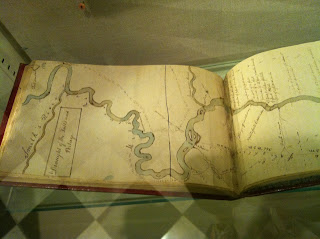While we were there we were brought in as new recruits. We had to learn how to march, shoot, get inoculated for small pox, and find out how much we were paid and what we ate.
How many teeth did you need to have in order to be a soldier in the Continental Army?
Well, you only needed two teeth. (as long they met -one on the top and one on the bottom) The reason? So that you could tear your powder cartridge. But, what if you didn't have two teeth that met? Then you were assigned to the artillery. I guess this means that you would not only have teeth but you would be deaf too!!
Here is a picture of our drill sergeant at the barracks. We were told that we were NOT the best set he's seen :-)
How long were recruits there?
Recruits had to be there for about 6-8 weeks. While there, we also had to be inoculated for small pox. This was a requirement by General Washington. Inoculation was a way to make sure that the disease didn't spread. First they would purge you of all liquids by giving you a special syrup that made you throw up or something to give you bad diarrhea and clean out your bowels. Then they would take an old scab of smallpox, grind it up, scratch your skin, and then rub the small pox onto it. You might get a little sick and break out all over your arm, but it was sure better than getting the full blown virus. This might have been one of the strongest reasons why the Americans eventually won the war.
What would happen if you tried to desert, or leave?
Typically if you were caught deserting, you would be executed. BUT, because there was low enrollment into the army they decided to not do that. Instead, they would whip you anywhere from 80-1000 lashes with a cat-o-nine tails. YIKES!!
What did you eat while you were there?
You actually ate pretty well. You were guaranteed bread, vinegar (to keep the disease scurvy away), a pint of beer, and meat while you were training at the barracks. When you were actually out on the campaign and fighting....you weren't guaranteed food. They tried to get you salted pork or beef (it traveled and kept well) and some bread.
What were you paid like?
Well...the Continental Army wasn't quite the best at paying the soldiers. You were the highest paid soldiers in the world though at $6.50. Except, you would be paid in paper money...which was basically worthless. You would have rather have been paid in gold or silver like the British army.
We also went to go see the actual place where the battlefield took place at the Mercer House outside of Princeton. (Where the actual university is. I went there later that day!)
The Mercer House is right behind me when I took this picture and looking out towards the battlefield. You can kind of see small white pillars in the background of this picture. Can you imagine over a thousand British soldiers marching towards you all at once here? I would be scared senseless at the sight!!!
Inside of the house:
There was a really neat museum over the battle. In it I was able to see a really nice display of guns that would have been used during the Revolutionary War.
The guns shot out musket balls. These little balls could do a LOT of damage. To illustrate, the guide showed us an example he has used for school kids when they come and visit. Notice the first picture that shows the way a musket ball would enter a body: (musket all is situated on top and the bullet hole is in the middle of the phone book)
NOW...check out what it looks like when it is coming out the back........
IMAGINE THAT GOING THROUGH YOUR BODY!!!!!








.JPG)







